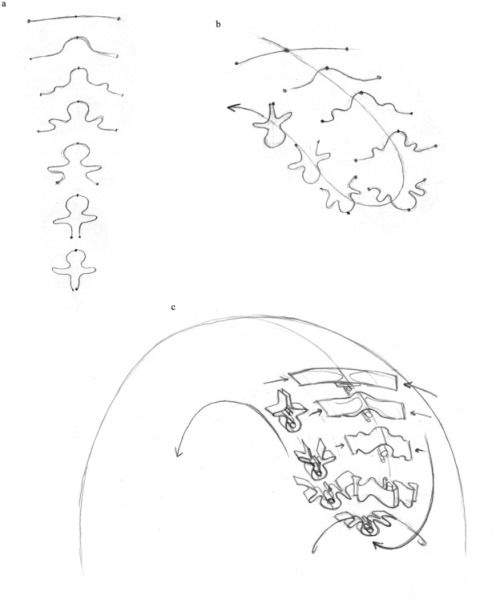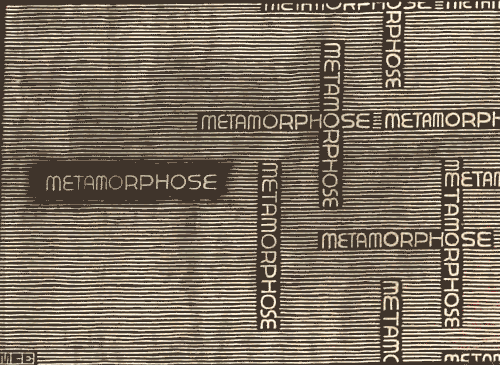Embryo Geometry: A Theory Of Evolution From A Single Cell To The Complex Vertebrate Body










Embryo geometry: a theory of evolution from a single cell to the complex vertebrate body
24 “blueprints” that illustrate how the musculoskeletal, cardiovascular, neurological, and reproductive systems evolve through the mechanical deformation of geometric patterns. These images show how the vertebrate body might have evolved from a single cell during the evolutionary time and during individual development.
Though neither rigorous nor exhaustive in an empirical sense, our model offers an intuitive and plausible description of the emergence of form via simple geometrical and mechanical forces and constraints. The model provides a template, or roadmap, for further investigation, subject to confirmation (or refutation) by interested researchers.
The concept of “embryo geometry” suggests that the vertebrate embryo might be produced by mechanical deformation of the blastula, a ball of cells formed when a fertilized egg splits. As these cells multiply, the volume and surface area of the ball expand, changing its shape. According to the hypothesis, the blastula preserves the geometry of the initial eight cells generated by the egg’s first three divisions, which establish the three axes of the vertebrate body.
Though speculative, the model addresses the poignant absence in the literature of any plausible account of the origin of vertebrate morphology. A robust solution to the problem of morphogenesis—currently an elusive goal—will only emerge from consideration of both top-down (e.g., the mechanical constraints and geometric properties considered here) and bottom-up (e.g., molecular and mechano-chemical) influences.
Origin of the vertebrate body plan via mechanically biased conservation of regular geometrical patterns in the structure of the blastula, David B. Edelman, Mark McMenamin, Peter Sheesley, Stuart Pivar
Published: September 2016, Progress in Biophysics and Molecular Biology DOI: 10.1016/j.pbiomolbio.2016.06.007
More Posts from Matematicaulysses and Others

Uma imagem que representa uma relação muito interessante em matemática.
A soma de cubos pode ser transformada no quadrado da soma de uma PA.
#math #matematica #algebra #geometria #demonstração #ulysses bueno #prof ulysses tdb

M. C. Escher - Metamorphose II

Plate 17. Guide to the construction of Gothic details. 1888.
Internet Archive

Mais uma da série “Olhando demonstrações”!
#geometria #fractal #demonstração matemática #demonstrações matemáticas #prof Ulysses Bueno #profulyssestdb #somas infinitas #PG infinita



Bruno Munari, (1960), The Square, Translation by corrainiStudio, Corraini Edizioni, Mantova, (2006-)2011, pp. 62-63
Calculating the surface area of a sphere. Found on Imgur.
Realmente os matemáticos são muito otimista com relação ao conhecimento, mas isso pode ser frustante para muitos estudantes, pois sem persistência não há como continuar nesse meio!
math problem: *begins with “we know that..”*
me: WE dont know SHIT

@vivalasestrellas

-
 mo-tsvetkov liked this · 4 weeks ago
mo-tsvetkov liked this · 4 weeks ago -
 sunflowerpandemonium reblogged this · 4 weeks ago
sunflowerpandemonium reblogged this · 4 weeks ago -
 thekiddochow reblogged this · 5 months ago
thekiddochow reblogged this · 5 months ago -
 discopunkt reblogged this · 9 months ago
discopunkt reblogged this · 9 months ago -
 istillkidddo liked this · 10 months ago
istillkidddo liked this · 10 months ago -
 mermanonfire liked this · 1 year ago
mermanonfire liked this · 1 year ago -
 thedaylightworldofbrian liked this · 1 year ago
thedaylightworldofbrian liked this · 1 year ago -
 panicinthestudio reblogged this · 1 year ago
panicinthestudio reblogged this · 1 year ago -
 k-st-g reblogged this · 1 year ago
k-st-g reblogged this · 1 year ago -
 elwinka liked this · 1 year ago
elwinka liked this · 1 year ago -
 dem-arts-tho reblogged this · 1 year ago
dem-arts-tho reblogged this · 1 year ago -
 outragedslime-draws liked this · 1 year ago
outragedslime-draws liked this · 1 year ago -
 alpha-khimera liked this · 1 year ago
alpha-khimera liked this · 1 year ago -
 honeycomb-butch liked this · 2 years ago
honeycomb-butch liked this · 2 years ago -
 headlessmind reblogged this · 2 years ago
headlessmind reblogged this · 2 years ago -
 tombombadilhateblog liked this · 2 years ago
tombombadilhateblog liked this · 2 years ago -
 wyrmlover liked this · 2 years ago
wyrmlover liked this · 2 years ago -
 rkas00 liked this · 2 years ago
rkas00 liked this · 2 years ago -
 headlessmind liked this · 2 years ago
headlessmind liked this · 2 years ago -
 hegelianfemboy liked this · 2 years ago
hegelianfemboy liked this · 2 years ago -
 mothchewed liked this · 2 years ago
mothchewed liked this · 2 years ago -
 computerfrog2000 reblogged this · 2 years ago
computerfrog2000 reblogged this · 2 years ago -
 hotwolfmommy reblogged this · 2 years ago
hotwolfmommy reblogged this · 2 years ago -
 el-you liked this · 2 years ago
el-you liked this · 2 years ago -
 hotwolfmommy liked this · 2 years ago
hotwolfmommy liked this · 2 years ago -
 eldritchhousekeeper liked this · 2 years ago
eldritchhousekeeper liked this · 2 years ago -
 perseussryyaxx liked this · 2 years ago
perseussryyaxx liked this · 2 years ago -
 paulfe liked this · 2 years ago
paulfe liked this · 2 years ago -
 alcoholic-muffin liked this · 2 years ago
alcoholic-muffin liked this · 2 years ago -
 memento-mariii liked this · 2 years ago
memento-mariii liked this · 2 years ago -
 dressedsalad liked this · 2 years ago
dressedsalad liked this · 2 years ago -
 art-of-mathematics reblogged this · 2 years ago
art-of-mathematics reblogged this · 2 years ago -
 eulers-entity liked this · 2 years ago
eulers-entity liked this · 2 years ago -
 u-zaborav liked this · 2 years ago
u-zaborav liked this · 2 years ago -
 beachchairbookworm liked this · 2 years ago
beachchairbookworm liked this · 2 years ago -
 onpyre reblogged this · 2 years ago
onpyre reblogged this · 2 years ago -
 onpyre liked this · 2 years ago
onpyre liked this · 2 years ago -
 cosmicblame reblogged this · 2 years ago
cosmicblame reblogged this · 2 years ago -
 carolinaliraleyton-blog liked this · 2 years ago
carolinaliraleyton-blog liked this · 2 years ago -
 tumblknaut reblogged this · 2 years ago
tumblknaut reblogged this · 2 years ago -
 matematicaulysses reblogged this · 2 years ago
matematicaulysses reblogged this · 2 years ago -
 gloom-armor-knight liked this · 2 years ago
gloom-armor-knight liked this · 2 years ago -
 narwa liked this · 2 years ago
narwa liked this · 2 years ago -
 euphoriaccolyte liked this · 2 years ago
euphoriaccolyte liked this · 2 years ago
Blog do profº Ulysses TDBueno destinado a curiosidades, demonstrações, links, trabalhos, artigos, imagens e tudo que possa mostrar a matemática no mundo.
107 posts